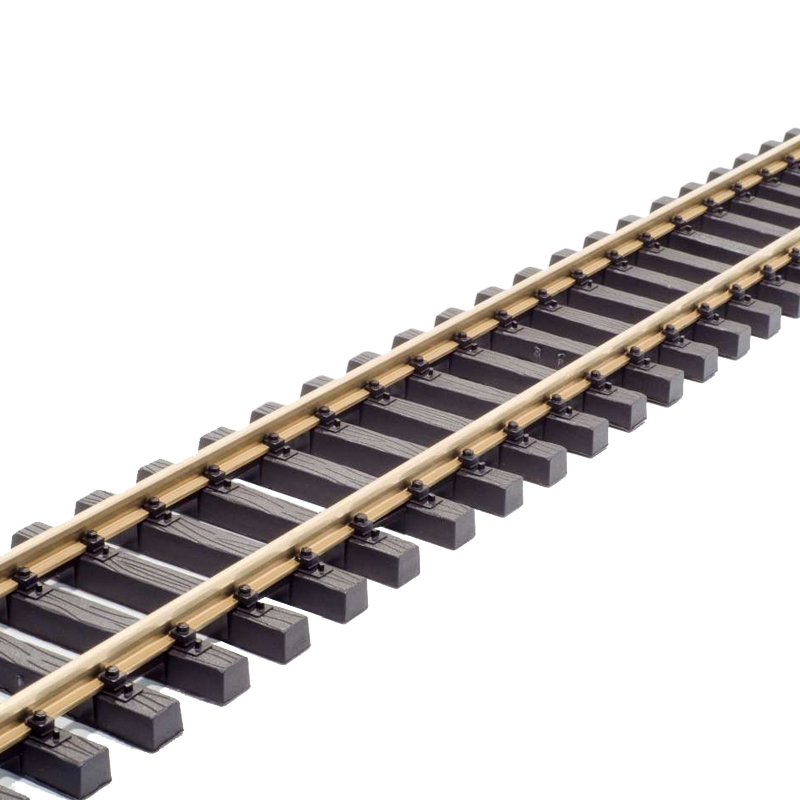

$559.95
Improved durability and quality of tie strips, made out of UV stabilized HDPE.
More information about our track:
All our G-scale LGB compatible track and switches are exclusively Made in Germany. We have two types of rail that is used for our products:
The most commonly used material is Brass.
Brass is not Brass is not Brass. And don't believe people that talk about Virgin Brass. Brass is not a material that is found in the ground, and is not a natural product. Brass in an Alloy made out of different material. Two of the major components are Copper and Zinc. The more copper is used the more "golden" brass looks. Th more bright brass is the less Copper is in there and the more Zinc. Zinc often can be contaminated contributing to Zinc rod. So Brass can actually pit. Now Zinc is cheaper than Copper hence the more Zinc the cheaper the material market price but the lower the quality of the Brass. Conductivity and durability are a factor of the Brass alloy. Some Brass Alloys contain even lead, outlawed in many US States, but how do you know that your Brass supplier isn't it up for cost cutting. Ask for a certified copy of the Brass Allow Chemical analysis and have them certify that this is the quality your are buying. If they don't do this, you know you are buying inferior Brass. TRAINLI and its suppliers (Trainline Gartenbahnen und Thiel) stand behind their Brass and we have certificates to proof it.
In this section we show all our brass track and under NpB we show all the corrosion free track. Brass is a very good conductor for power, but oxidation (more in certain climates than in others) requires cleaning before you can “play” with the layout (Scotch Pad on a stick, track cleaning block, track cleaning loco, track cleaning car with motorized pads - powered options while more expensive are more convenient). A oxidation free approach is NpB rail(see the NpB or the track overview section for more information)
When it comes to Brass you have to be careful about the material choices. Our G-scale brass track is best German qualitt. Cheaper brass (mostly from China) is softer and hence wares quickly (one Christmas layout in San Francisco had to be re-done already after 2 weeks of operation).
Code 332, 250, 215—what is the story?
We carry exclusively code 332. Code 332 is the highest qulaity and gives you a safety for the rough outdoor environments that our G-scale layouts might be facing. If you accidently step on code 332 - nothing is going to happen to the track, but if you try this with code 250 or even code 215, the track maybecvome unusable. And frankly speaking at 10' distance you couldn't tell the differnce anyhow, especially if the trakc is coverd with crushed stone.
But for the purist of G-scale track hobbyists here is more info:
As for the code if you follow NMRA they recommend a minimum of code 250 (= .0250 height). While the purist say code 250 (or even code 215), consider that code 332 is only 0.082" of an inch higher then code 250. I found that you have more product options when it comes to code 332 and when you are outdoors the overall sturdiness of 332 (e.g. when accidently stepped on the track) is definitely an advantage. And while code 250 might clear all the flanges, but as soon as crusher fines come into play you might have lost that clearing (especially outdoors) where the elements always mess with your layout. Indoors you can try code 250 because the two risk factors are gone. Another point is that code 250 is not a standard across all manufacturers. The rail foots and rail heads differ between the various manufacturers and hence you maybe bound to use one single manufacturer because you can’t mix and match easily. We know of one product whose rail head is identical to code 332 (so you actually need to bend that with a 332 bender versus 250 bender). In those cases the “slimmer” looks of code 250 has been almost eliminated because they didn’t shrink the rail proportionally by 25% so you end up with less height but similar width which we call the Garfield look (“he is not chubby he is just under-tall”). Additionally modern prototypical rail to scale would be actually leading to code 300. Therefore the modern rail environment is much better served by code 332 then code 250. Additionally with a height difference of 0.082 you can hardly see a difference at 5’ distance and for me (and I am a rivet counter) the disadvantages outweigh the looks.
European or American ties?
This question is actually a misnomer. There is for the most part no such thing as European or American ties. The separation is different - standard gauge or narrow gauge. American and European narrow gauge railroads used very similar ties as they are reflected in our standard (LGB compatible) ties with 11 ties per foot. Standard gauge railroad ties are repsented with thinner ties and 14 ties per foot. Keep this in mind when you order.
More important is actually the tie-strip quality. You need to watch for sturdy rail chairs, otherwise they snap. The rail chairs should also have no side to side “slip” because that may fluctuate your rail gauge (width) and cause operation problems.
Please wait! Content loading.....
